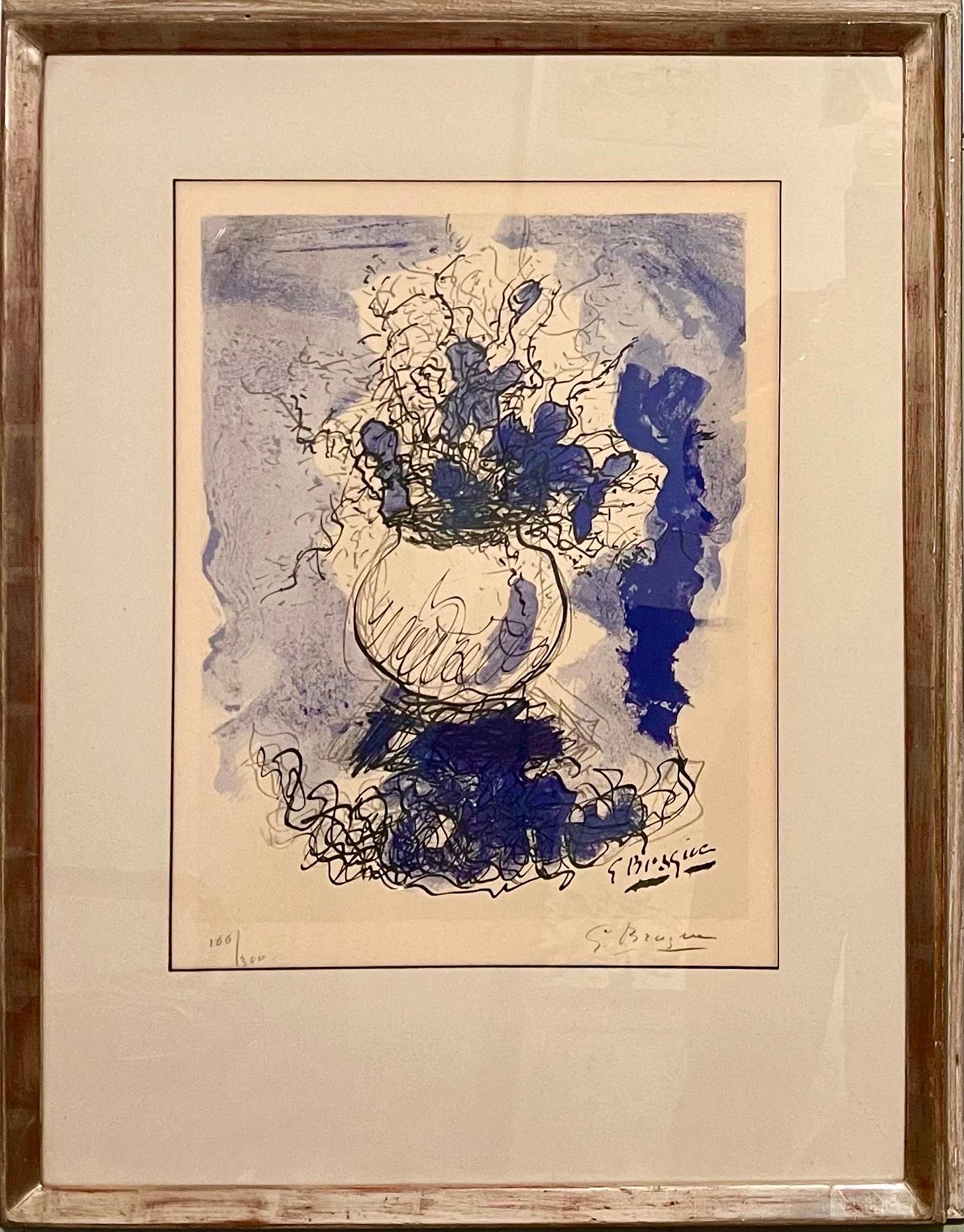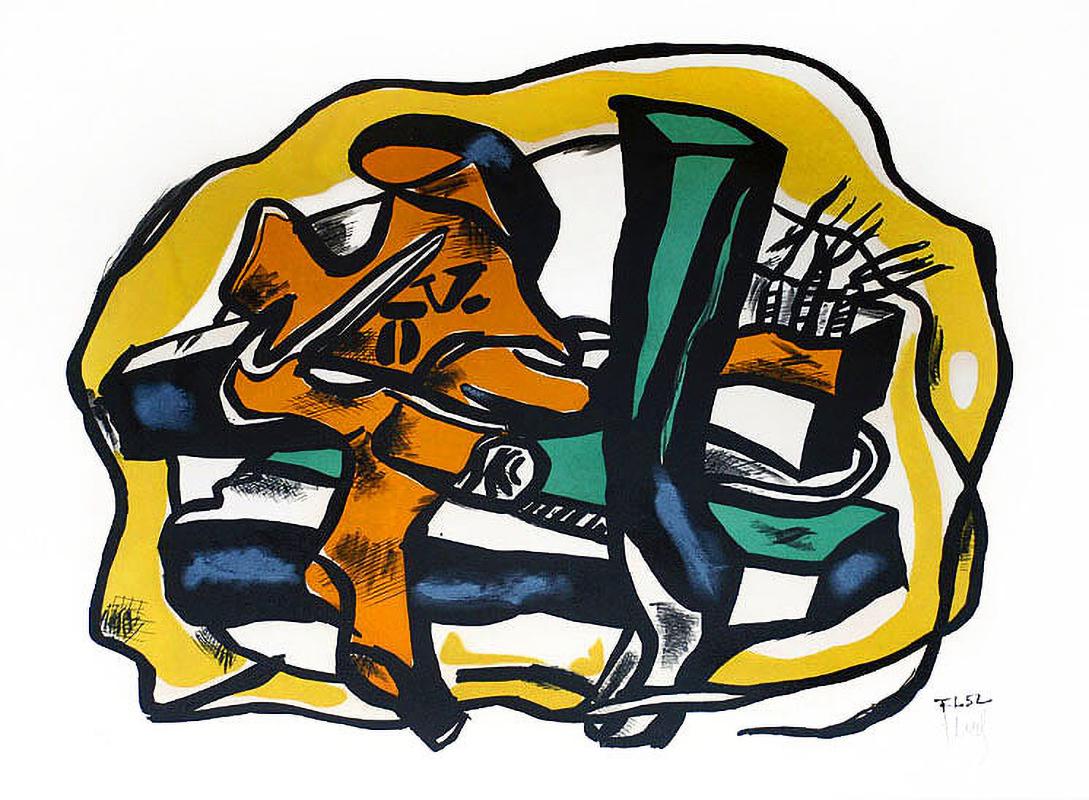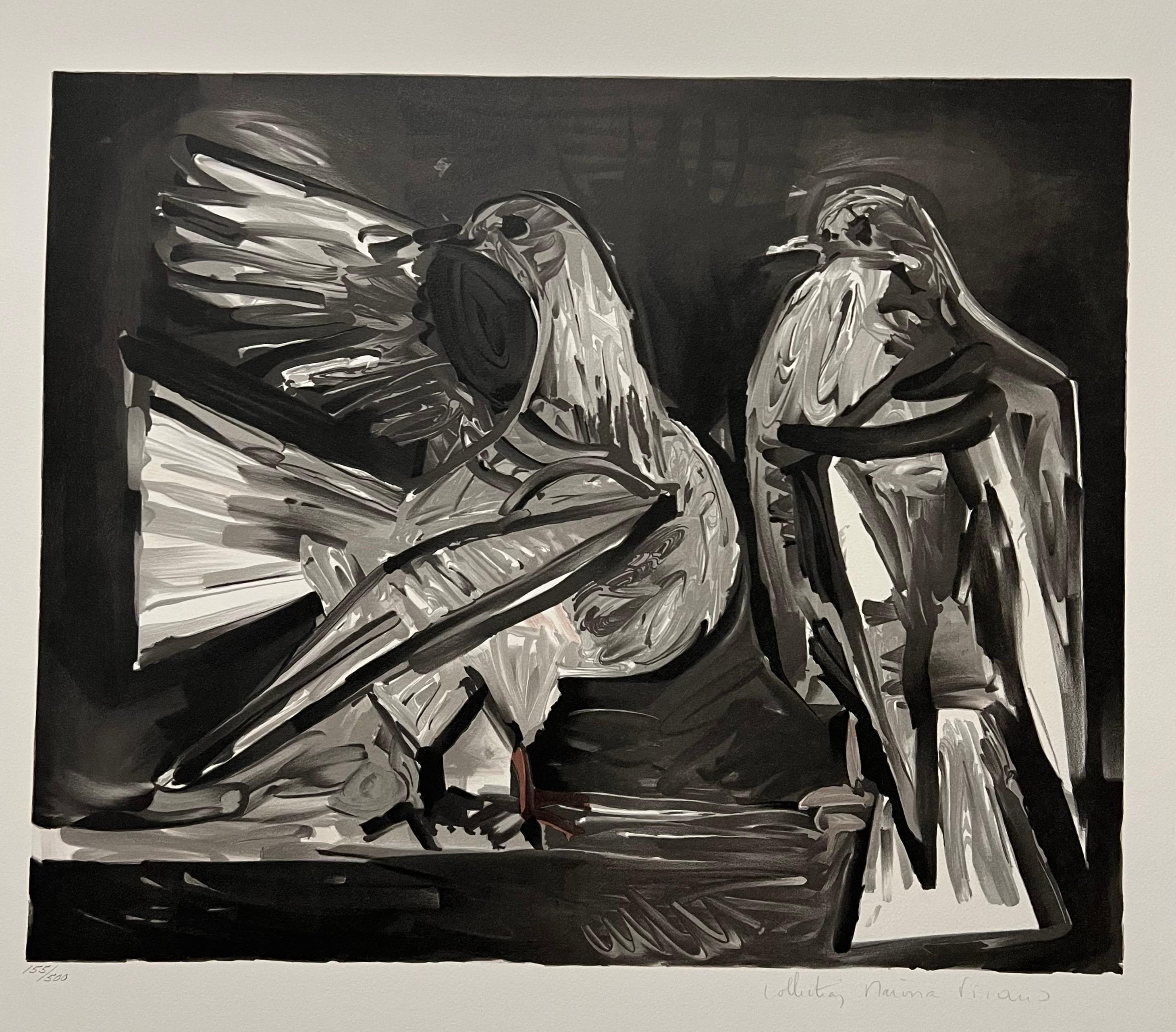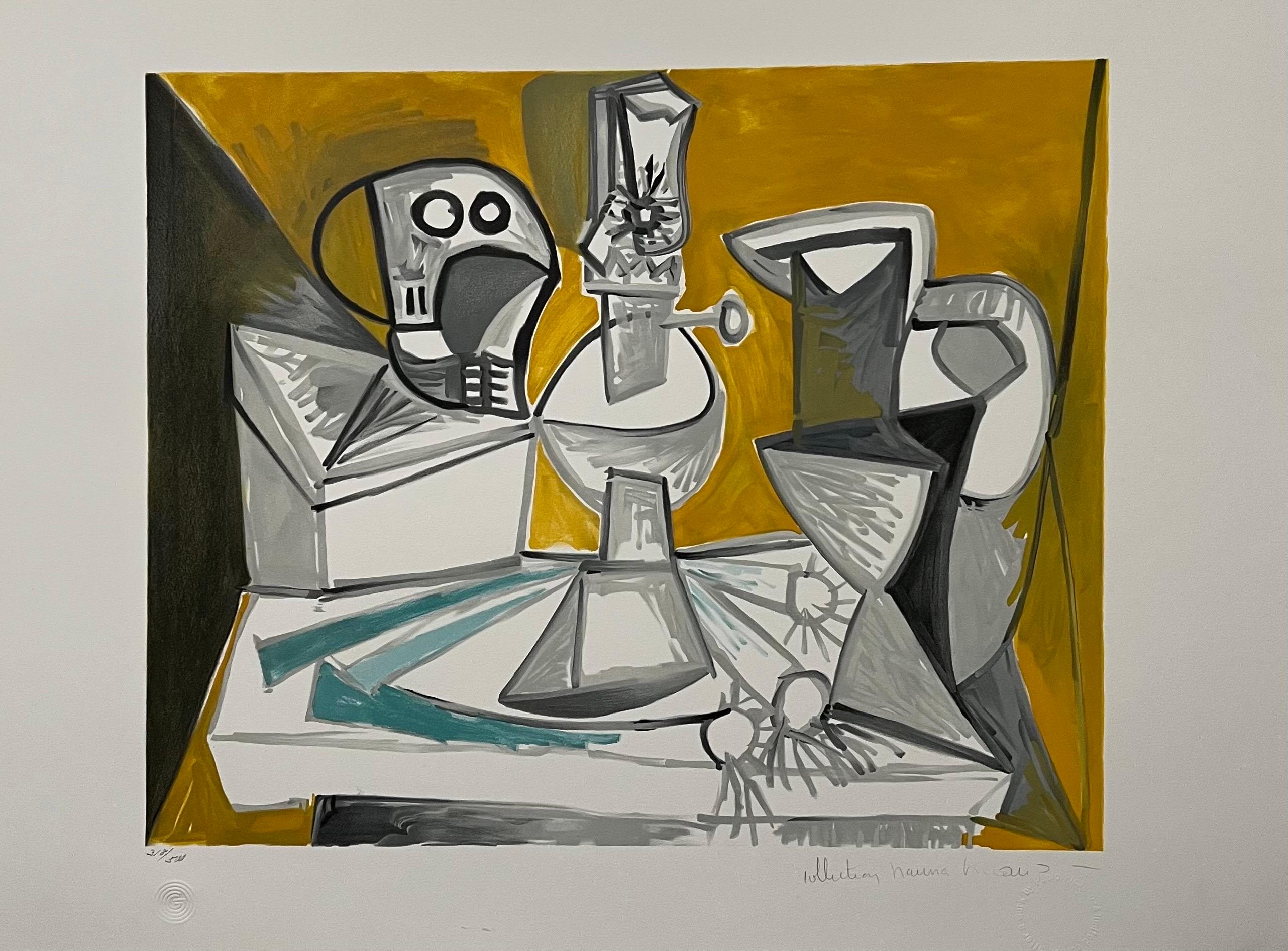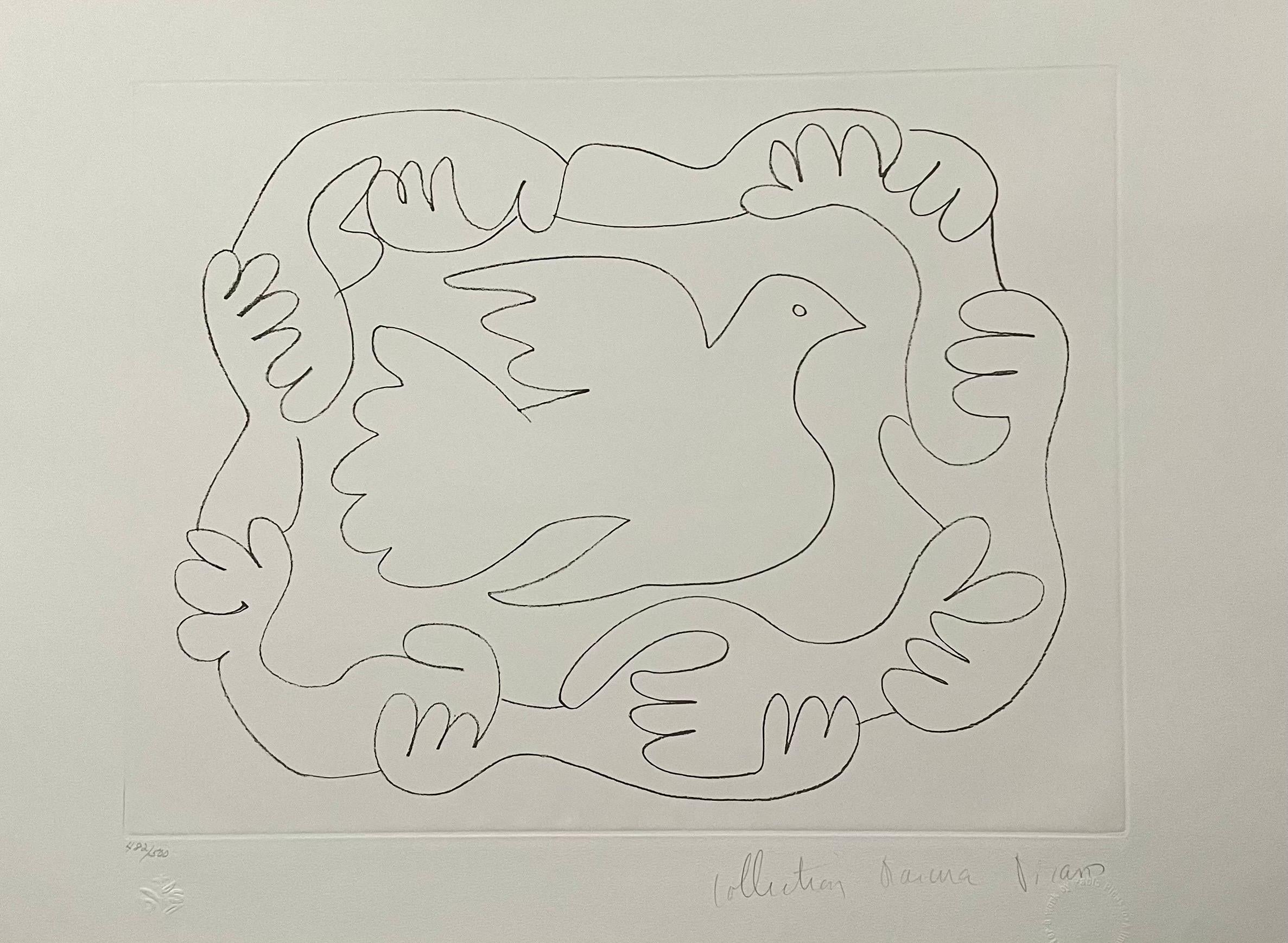Items Similar to Large Venezuelan Jewish Modernist Lithograph Menorah Judaica
Want more images or videos?
Request additional images or videos from the seller
1 of 8
Marius SznajdermanLarge Venezuelan Jewish Modernist Lithograph Menorah Judaica
About the Item
Marius Sznajderman was a painter, printmaker and scenic designer living and working in the United States.
Born in Paris, France in 1926 his Jewish parents had migrated to France from Poland in 1923. In November 1942 the family fled Nazi-occupied France for Spain before settling in Caracas, Venezuela. He attended the School of Fine Arts in Caracas where his teachers included illustrator Ramon Martin Durban, scenic designer Charles Ventrillon-Horber and painter Rafael Monasterios. and immigrated to the United States in 1949, where he received a Bachelor of Fine Arts and Master of Fine Arts from Columbia University in New York. He settled in Hackensack, New Jersey, where he lived and had a studio for more than 50 years before moving to Amherst, Massachusetts in 2015. His work, which includes painting, prints and collages, as well as set designs, is in more than 45 museum and public institution collections in the United States, Latin America and Israel. He held more than 40 solo exhibitions at galleries and museums and participated in more than 75 group shows around the globe.
He helped found the Taller Libre de Arte, an experimental workshop for the visual arts, sponsored by the Ministry of Education. The Taller Libre de Arte was a center for young artists to work and to meet with critics and intellectuals to discuss avant-garde ideas and artistic trends from Europe and Latin America. Among the notable artists who participated in the Taller Libre de Arte were Ramón Vásquez Brito, Carlos González Bogen, Luis Guevara Moreno, Mateo Manaure, Virgilio Trómpiz, Alirio Oramas, Dora Hersen, Alejandro Otero, Jesús Rafael Soto, Pascual Navarro, Aimée Battistini, José Fernández Díaz, Narciso Debourg, Oswaldo Vigas and Perán Erminy.
Sznajderman’s early works as a student and young artist showed the influence of Cubism and Expressionism with subject matter ranging from figures to still life to Venezuelan landscapes. His work often explored Latin American themes, art and architecture.
In 1948 Sznajderman was awarded the art student’s prize for a watercolor in the annual National Gallery exhibit. In 1949 Sznajderman had a solo exhibition at the Taller Libre de Arte. The exhibit catalogue was written by Sergio Antillano, a prominent Venezuelan writer and critic.
That same year, Sznajderman immigrated to the United States to attend Columbia University, where he studied with scenic designer J. Woodman Thompson and printmaker Hans Alexander Mueller. He received a Bachelor of Science degree with a major in scenic design in 1953, after which he was drafted into the U.S. Army. In the military he worked as an artist-illustrator, completing his service in 1955. He returned to Columbia on the G.I Bill to attend Teachers College, where he received a Master of Fine Arts in art education.
During the 1950s Sznajderman created set designs for Circle in the Square Theatre, the French Art Theatre and the Felix Fibish Dance Company, all in New York. By the late 1950s, however, his focus was shifting to fine arts and teaching.
In 1960 Sznajderman was among the three founders, along with painters Sam Weinik and Ben Wilson, of the Modern Artists Guild (MAG), an association of modern artists working in northern New Jersey. Among the artists who were early members of MAG were Esther Rosen, Alexandra Merker, Erna Weill, Jerry Goldman, Lillian Marzell and Evelyn Wilson.
In the 1950s, 1960s and 1970s, in addition to painting and printmaking, Sznajderman taught art, art history and design at a number of institutions including New York University, the School of Visual Arts, Fairleigh Dickinson University and the Ridgewood (N.J.) School of Art. He also taught art in New Jersey public schools under federal and state grants. During this period, Sznajderman’s work ranged from drawings, woodcuts and lithographs to watercolor and acrylic paintings and collages. He produced still life, figures, landscapes and seascapes. Inspirations included Venezuelan remembrances, culture and folklore; Mexican art and pre-Columbian imagery; as well as architecture and theater. Other works have been inspired by Greek mythology and the Commedia dell’arte. Contemporary events, such as the Vietnam War and the assassination of the Rev. Martin Luther King, Jr., also inspired some works.
From 1974 to 1983 Sznajderman served as director of Galeria Venezuela in New York City for the National Council of Culture and Fine Arts of Venezuela (CONAC) while continuing to paint and exhibit. From 1980 to 1986 he oversaw the selection and coordination of the international editions of prints for AGPA (Actualidad Grafica – Panamericana), a project of the Latin American Container Corporation of America (later Smurfit Carton de Venezuela).
Throughout his career, Sznajderman has also explored Jewish themes, including works in remembrance of the Holocaust. In 1988 he produced a limited-edition print, in collaboration with his uncle, the Yiddish journalist and author S.L. Shneiderman, on the occasion of Shneiderman’s 80th birthday. The print featured a 1938 poem by Shneiderman, “Elegy for My Shtetl,” written in Yiddish. The Yiddish text for the print was typeset using the last linotype machine used to print the New York-based Yiddish newspaper, The Forward. In 1989 he designed and supervised the production of a Holocaust memorial monument for Temple Beth El in Hackensack, New Jersey. Other works have explored Nazi concentration and extermination camps, the Vichy government and the Holocaust in France.
For many years Sznajderman had a deep friendship and intimate creative relationship with Venezuelan painter Oswaldo Vigas. In 1987, following a trip of the two families to the Venezuelan Andes, a two-person show of landscapes by Sznajderman and Vigas was held at the venerable Ateneo de Caracas, Galeria los Espacios Calidos.
In 1991 the Contemporary Art Museum of Caracas produced a retrospective exhibit of Sznajderman’s work.
In 2001 Sznajderman began a collages and collage constructions series using Yiddish as a leitmotif. A selection of the works were exhibited at the Yiddish Book Center, Amherst, Massachusetts in 2005-2006.
In 2005, Venezuelan poet Hugo Brett Figueroa published the book "Scargot" with illustrations by Sznajderman. Sznajderman also illustrated the 1993 book “Who Were the Pre-Columbians?” by Bernard Barken Kaufman and “Magicismos,” a book of poems by the Venezuelan poet Enrique Hernandez D’Jesus, published in 1989.
In 2007, Warsaw Ghetto Revolt mural project and a Nazi concentration camp woodcut series created in 1958 and 1959, was exhibited at the Puffin Cultural Forum in Teaneck, New Jersey.[8] In 2011 and 2012 he produced the “Yanaka” series of collages on paper and a large collage construction using Chiyogami - traditional Japanese printed paper - purchased in 1990 in Tokyo.
In 2011 Sznajderman created seven collages using unauthorized lithographs by Salvador Dali as material. The collages were reproduced in a limited-edition booklet titled “Dali, Dumas and Me.” The booklet described a series of events involving the late painter and printmaker Jorge Dumas, who had printed the Dali lithographs. The booklet was presented in 2013 during a solo exhibit by Sznajderman in New York City at Chashama Exhibit Space.
More recently, Sznajderman created a series of print-collages composed from early serigraphs produced in the 1960s. He continued to work and exhibit until the final weeks of his life.
Permanent Collections and Exhibitions
Sznajderman's work is represented in the permanent collections of more than 45 museums and institutions, primarily in the United States but also in Europe, Latin America and Israel. They include the Smithsonian Institution, the Library of Congress, Instituto Nacional de Bellas Artes y Literatura in Mexico City, Museo de Bellas Artes (Caracas), the Museum of Jewish Heritage in New York, the Cincinnati Art Museum, the Simon Wiesenthal Center, the Birmingham Civil Rights Institute, the Irish Museum of Modern Art in Dublin and Yad Vashem in Jerusalem.
- Creator:Marius Sznajderman (1926 - 2018, American, French)
- Dimensions:Height: 21.75 in (55.25 cm)Width: 29.75 in (75.57 cm)
- Medium:
- Movement & Style:
- Period:
- Condition:very minor creasing at margins.
- Gallery Location:Surfside, FL
- Reference Number:1stDibs: LU38212986472
Marius Sznajderman
Born in Paris in 1926, Marius Sznajderman escaped with his parents from France in November of 1942 and lived in Venezuela until 1949, at which time he moved to the United States. He studied at the Museum of Fine Arts in Caracas and Columbia University. In Caracas, he was a founding member of Taller Libre de Arte. In his 40 years as an artist, he has had numerous one-man shows in the US and South America, and his work is in the permanent collections of many important museums.
About the Seller
4.9
Platinum Seller
These expertly vetted sellers are 1stDibs' most experienced sellers and are rated highest by our customers.
Established in 1995
1stDibs seller since 2014
1,566 sales on 1stDibs
Typical response time: 1 hour
- ShippingRetrieving quote...Ships From: Surfside, FL
- Return PolicyA return for this item may be initiated within 3 days of delivery.
More From This SellerView All
- Georges Braque Bouquet de Fleurs Lithograph Bold Blue Hand Signed Ltd Ed PrintBy Georges BraqueLocated in Surfside, FLGeorges Braque (French, 1882-1963) Bouquet de Fleurs Lithograph in colors, 1957. Published by Maeght, printed by Mourlot, Paris, France Numbered 166/300 and hand signed in pencil. ...Category
20th Century Modern Figurative Prints
MaterialsLithograph
- Pablo Picasso Estate Hand Signed French Expressionist Lithograph "Deux Pigeons"By (after) Pablo PicassoLocated in Surfside, FLPablo Picasso (after) "Deux Pigeons" limited edition print on Arches paper, Hand signed by Marina Picasso lower right and numbered 155/500 lower left Fro...Category
20th Century Modern Abstract Prints
MaterialsLithograph
- Pablo Picasso Estate Hand Signed Lithograph Abstract Cubist CompositionBy (after) Pablo PicassoLocated in Surfside, FLPablo Picasso (after) "Tete De Mort, Lampe, Cruches Et Poireaux" limited edition print on Arches paper, Hand signed by Marina Picasso lower right and numbered 318/500 lower left From the estate of Pablo Picasso with an embossed blindstamp in the lower right side of the piece. After Pablo Picasso's death in 1973, his granddaughter Marina authorized the printing of these original lithographs, which have come to be known as the Picasso Estate...Category
20th Century Modern Abstract Prints
MaterialsLithograph
- Pablo Picasso Estate Hand Signed Lithograph Engraving Fauvist Dove of PeaceBy (after) Pablo PicassoLocated in Surfside, FLPablo Picasso (after) "Etudes des Mains et Colombe" limited edition print on Arches paper, Hand signed by Marina Picasso lower right and numbered 482/500 lower left From the estate of Pablo Picasso with an embossed blindstamp in the lower right side of the piece. After Pablo Picasso's death in 1973, his granddaughter Marina authorized the printing of these original lithographs, which have come to be known as the Picasso Estate...Category
20th Century Modern Abstract Prints
MaterialsLithograph, Engraving
- Pablo Picasso Estate Hand Signed Fauvist Lithograph Woman Portrait Marie ThereseBy (after) Pablo PicassoLocated in Surfside, FLPablo Picasso (after) "Portrait de Marie Therese" limited edition print on Arches paper, Hand signed by Marina Picasso lower right and numbered 274/500 lower left From the estate of Pablo Picasso with an embossed blindstamp in the lower right side of the piece. After Pablo Picasso's death in 1973, his granddaughter Marina authorized the printing of these original lithographs, which have come to be known as the Picasso Estate Collection. The lithographs were meticulously created after the original works (Oil Paintings, Watercolors, Pastels, Charcoal Drawings, etc.) by Master Chromist Marcel Salinas, who worked closely with Picasso in his lifetime. They are printed in an edition of 500 on Arches paper. Embossed with the estate and chromist's stamp seals, along with the legend on the reverse "Approved by the heirs of Pablo Picasso". Image: 19 1/2" x 15". Paper: 28" x 20 3/4". Pablo Ruiz Picasso (1881 – 1973) was a Spanish painter, sculptor, printmaker, ceramicist, stage designer, poet and playwright who spent most of his adult life in France. Regarded as one of the most influential artists of the 20th century, he is known for co-founding the Cubist movement, the invention of constructed sculpture, the co-invention of collage, and for the wide variety of styles that he helped develop and explore. Among his most famous works are the proto-Cubist Les Demoiselles d'Avignon (1907), and Guernica (1937), a dramatic portrayal of the bombing of Guernica by the German and Italian air forces during the Spanish Civil War...Category
20th Century Modern Abstract Prints
MaterialsLithograph
- Henry Moore 1973 Lithograph edition 28/75 Sculpture Figures Reclining NudesBy Henry MooreLocated in Surfside, FLHenry Spencer Moore (1898 – 1986) Moore was born in Castleford, the son of a coal miner. He became well-known through his carved marble and larger-scale abstract cast bronze sculptures, and was instrumental in introducing a particular form of modernism to the United Kingdom later endowing the Henry Moore Foundation, which continues to support education and promotion of the arts. After the Great War, Moore received an ex-serviceman's grant to continue his education and in 1919 he became a student at the Leeds School of Art (now Leeds College of Art), which set up a sculpture studio especially for him. At the college, he met Barbara Hepworth, a fellow student who would also become a well-known British sculptor, and began a friendship and gentle professional rivalry that lasted for many years. In Leeds, Moore also had access to the modernist works in the collection of Sir Michael Sadler, the University Vice-Chancellor, which had a pronounced effect on his development. In 1921, Moore won a scholarship to study at the Royal College of Art in London, along with Hepworth and other Yorkshire contemporaries. While in London, Moore extended his knowledge of primitive art and sculpture, studying the ethnographic collections at the Victoria and Albert Museum and the British Museum. Moore's familiarity with primitivism and the influence of sculptors such as Constantin Brâncuși, Jacob Epstein, Henri Gaudier-Brzeska and Frank Dobson led him to the method of direct carving, in which imperfections in the material and marks left by tools became part of the finished sculpture. After Moore married, the couple moved to a studio in Hampstead at 11a Parkhill Road NW3, joining a small colony of avant-garde artists who were taking root there. Shortly afterward, Hepworth and her second husband Ben Nicholson moved into a studio around the corner from Moore, while Naum Gabo, Roland Penrose, Cecil Stephenson and the art critic Herbert Read also lived in the area (Read referred to the area as "a nest of gentle artists"). This led to a rapid cross-fertilization of ideas that Read would publicise, helping to raise Moore's public profile. The area was also a stopping-off point for many refugee artists, architects and designers from continental Europe en route to America—some of whom would later commission works from Moore. In 1932, after six year's teaching at the Royal College, Moore took up a post as the Head of the Department of Sculpture at the Chelsea School of Art. Artistically, Moore, Hepworth and other members of The Seven and Five Society would develop steadily more abstract work, partly influenced by their frequent trips to Paris and their contact with leading progressive artists, notably Pablo Picasso, Georges Braque, Jean Arp and Alberto Giacometti. Moore flirted with Surrealism, joining Paul Nash's modern art movement "Unit One", in 1933. In 1934, Moore visited Spain; he visited the cave of Altamira (which he described as the "Royal Academy of Cave Painting"), Madrid, Toledo and Pamplona. Moore made his first visit to America when a retrospective exhibition of his work opened at the Museum of Modern Art in New York City.[28] Before the war, Moore had been approached by educator Henry Morris, who was trying to reform education with his concept of the Village College. Morris had engaged Walter Gropius as the architect for his second village college at Impington near Cambridge, and he wanted Moore to design a major public sculpture for the site. In the 1950s, Moore began to receive increasingly significant commissions. He exhibited Reclining Figure: Festival at the Festival of Britain in 1951, and in 1958 produced a large marble reclining figure for the UNESCO building in Paris. With many more public works of art, the scale of Moore's sculptures grew significantly and he started to employ an increasing number of assistants to work with him at Much Hadham, including Anthony Caro and Richard Wentworth. Moore produced at least three significant examples of architectural sculpture during his career. In 1928, despite his own self-described extreme reservations, he accepted his first public commission for West Wind for the London Underground Building at 55 Broadway in London, joining the company of Jacob Epstein and Eric Gill..At an introductory speech in New York City for an exhibition of one of the finest modernist sculptors, Alberto Giacometti, Sartre spoke of The beginning and the end of history...Category
1970s Modern Abstract Prints
MaterialsLithograph
You May Also Like
- Deux PersonnagesBy André MassonLocated in Missouri, MOSigned Lower Right Numbered Lower Left 166/200 Framed Size: 33 x 25 inches Andre Masson was born in Balagne, France on January 4, 1896. He was an engraver, sculptor, stage designer...Category
1960s Modern Figurative Prints
MaterialsLithograph
- Profil RoseBy André MassonLocated in Missouri, MOSigned Lower Right Numbered 61/200 Sight Size: 27.5 x 21.5 Framed Size: 31.5 x 24.5 Andre Masson was born in Balagne, France on January 4,1896. He was an engraver, sculptor, stage d...Category
1960s Modern Figurative Prints
MaterialsLithograph
- Annuit Coeptis (mid century modern with Abraham Lincoln)By Saul SteinbergLocated in New York, NYSaul Steinberg Annuit Coeptis (with Abraham Lincoln, from The New York International Portfolio), 1966 Pencil signed and numbered on the front from the edition of 225 Unframed This Steinberg lithograph is titled Annuit Coeptis, which is one of the mottoes found on the Great Seal of the United States...Category
1960s Modern Abstract Prints
MaterialsLithograph
- The painter. 1943, paper, lithograph, 56x46 cmBy Marcel GromaireLocated in Riga, LVMarcel Gromaire (1892-1971) - The Painter. 1943, paper, lithograph, 56x46 cmCategory
1940s Modern Abstract Prints
MaterialsPaper, Lithograph
- Karel Appel, Little Boy, color lithograph, hand signed and numbered COBRA artistBy Karel AppelLocated in New York, NY"Little Boy" - charming 1960s silkscreen rarely seen on the market would look perfect in a child's room - or in any room in the house! Karel Appel Little Boy, 1969 Color lithograph ...Category
1960s Modern Abstract Prints
MaterialsLithograph
- Alexander Calder Lithographic cover Derrière le miroir 1973By Alexander CalderLocated in NEW YORK, NYAlexander Calder Lithographic cover: Derrière le miroir 1973: Lithographic cover sheet; 15 x 11 inches. Very good overall vintage condition. Unsigned from an edition of unknown. Por...Category
1970s Modern Figurative Prints
MaterialsLithograph
Recently Viewed
View AllMore Ways To Browse
French Modernist Designers
Jewish Large
Large Jewish Art
Jewish Large Paintings
Marius Marius
Marius And Marius
Architectural Drawing Modernist
Spanish Jewish
Jesus Large
Vintage Large Container
Judaica Lithograph
45 Three Modern Vintage
Contemporary Judaica
Cubism Still Life 20th Century
Fine Art Judaica
French Judaica
Jewish Heritage
Woodcut Modernist
